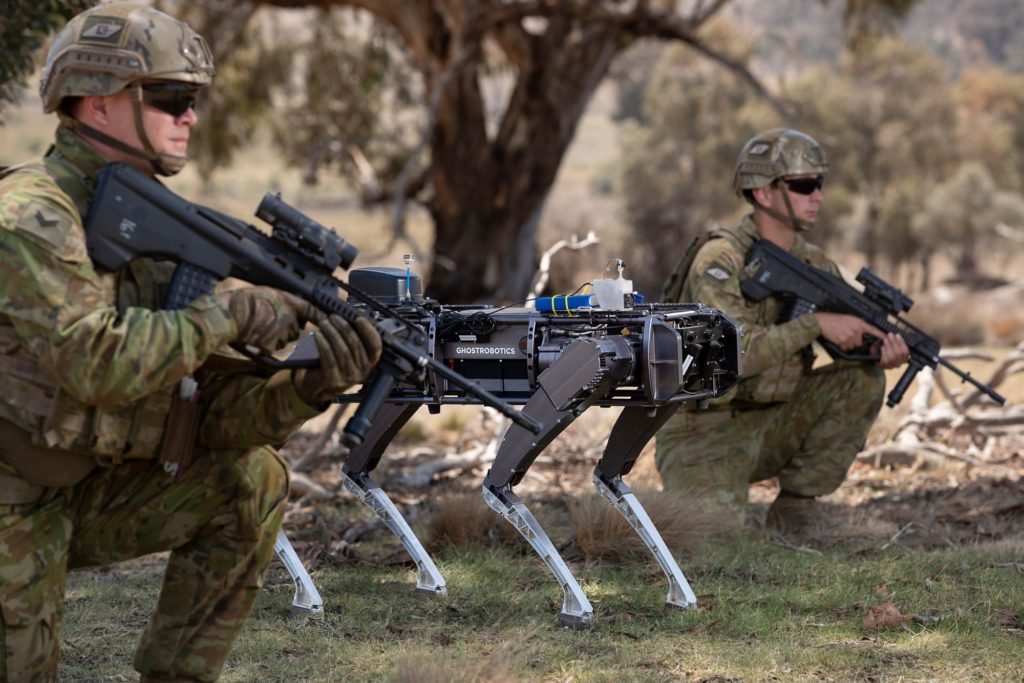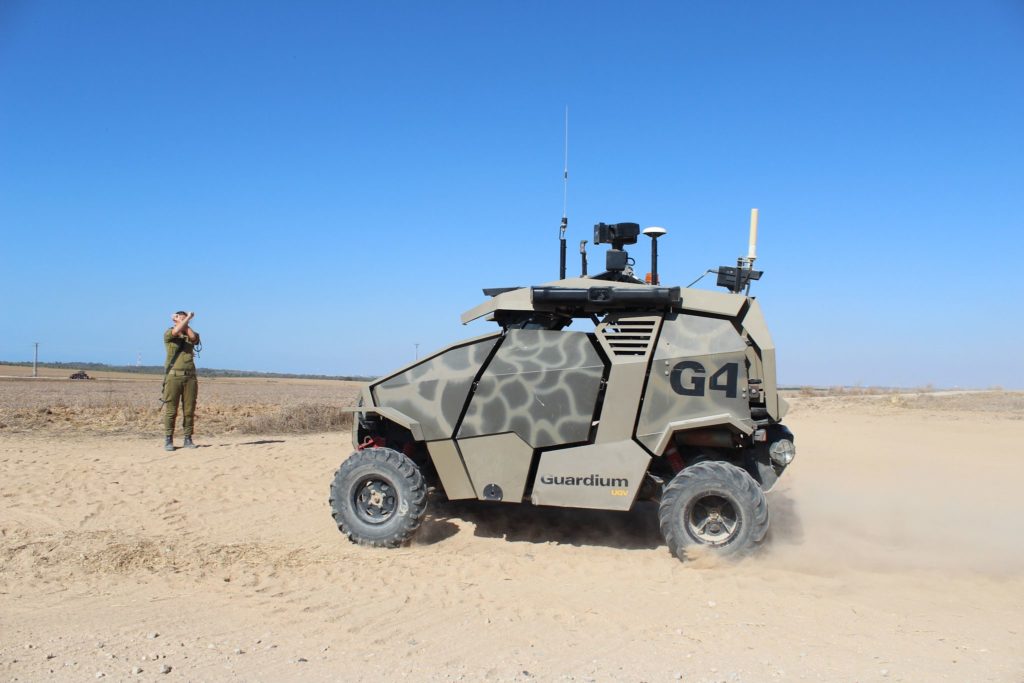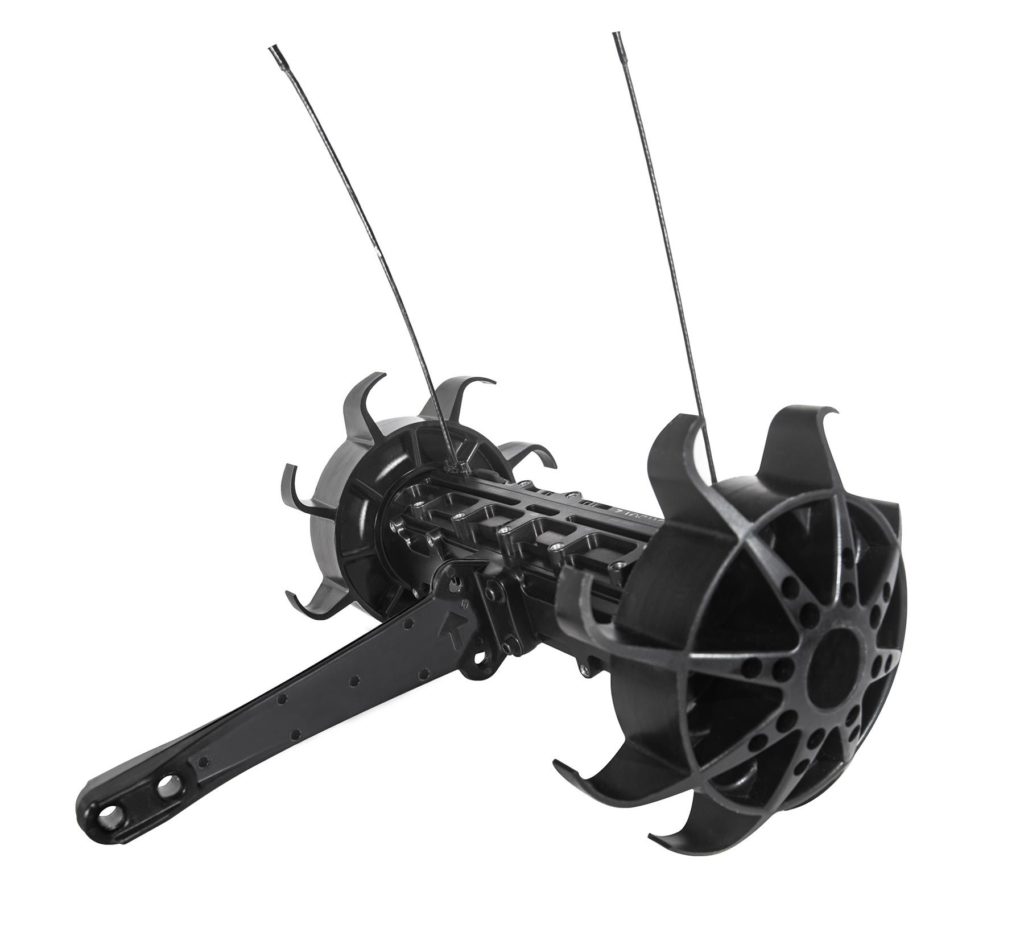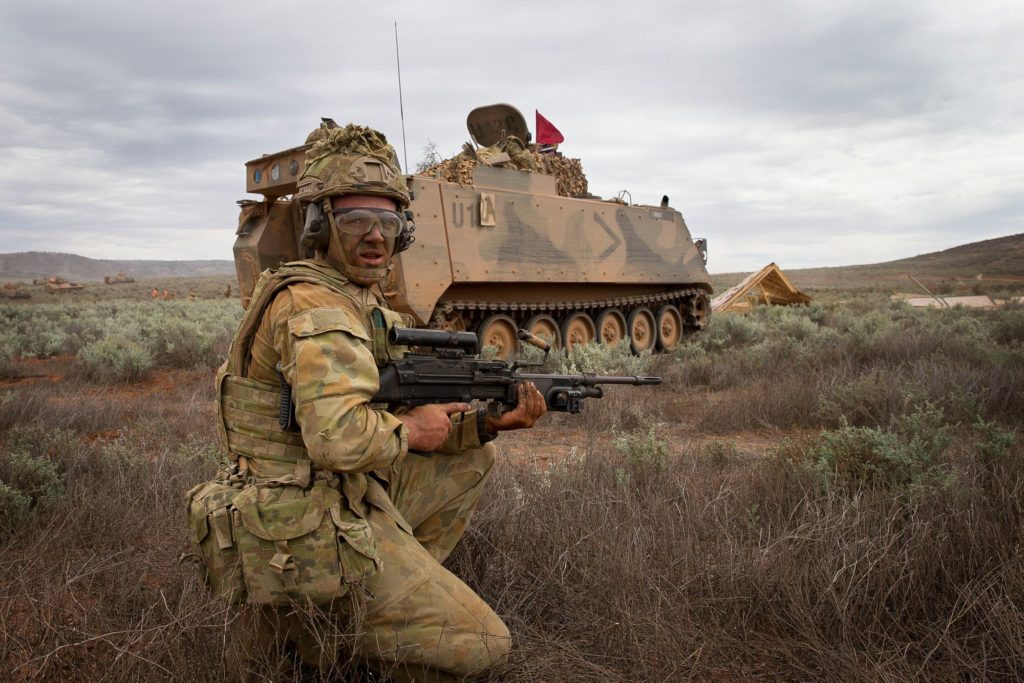Eyes on the future of military UGVs

By Max Blenkin
Warfare is evolving and the Australian Army, the largest operator of unmanned aerial systems in Australia, has more than just flying robots in its future.
In the conflict of the next decade, uncrewed armoured
vehicles could deliver soldiers to combat then evacuate the wounded. Humans
aboard scout vehicles could guide small uninhabited ground vehicles (UGVs) to
inspect a choke point for mines or improvised explosive devices. And while there
will always be a need for sweating soldiers to patrol, they will soon be
accompanied by a robotic wheeled ‘mule’ to carry packs, water and supplies, or
ammunition.
Army has long operated unmanned aircraft for intelligence,
surveillance, and reconnaissance (ISR), and specialist tracked robots for bomb
disposal. With UGV technology rapidly advancing, it is now thinking long and
hard about its terrestrial robotic future.
Some of these new technologies have already been tried out
in the field. During Exercise Talisman Sabre last year, the Army trialled the MAPS (Mission Adaptable Platform System) Mule, a
six-wheeled robotic vehicle made by Queensland company Praesidium
Global and able to transport a useful load of up to 850 kilograms.

It has also conducted trials with robotic
M113AS4 armoured personnel carriers. These vehicles have been converted by
BAE Systems Australia to be optionally manned, an emerging concept which
permits the vehicles to perform certain tasks autonomously or by remote
control. That could include evacuation of casualties from the battlefield. It
has also acquired a pair of quadruped robots made by US company Ghost Robotics that
resemble robotic dogs to assess the utility of legged robots.
Army is also examining what benefit it could gain from
uninhabited watercraft, of potential use for riverine scouting or ship-to-shore
resupply.
But this isn’t just about robot platforms. The Army is also
looking at how robotic systems and artificial intelligence (AI) could help
commanders make better, faster decisions. All this is in step with the Army’s
Robotic and Autonomous Systems (RAS) Strategy, released in October 2018.
The RAS strategy emerged from the Army Innovation Day in
2017, and leading this effort is LTCOL Robin Smith, staff officer for robotic
and autonomous systems within the Army’s Future Land Warfare Branch.
“It was obvious to the senior leadership that autonomous and
robotic systems were coming more to the fore in terms of the availability of
the tech in civilian and military world,” LTCOL Smith told ADBR. “That talks to
the over-arching premise that Army is operating under at the moment which is ‘Accelerated
Warfare’ – this idea that Army or defence or the nation is in persistent
competition.
“That technology is out there,” he added. “Remote control
cars have been around forever, and they are getting better and better. The
human interface to those machines is improving with things like virtual reality
and augmented reality. It is now on your phone. The seniors appreciated that
these type of systems would become increasingly important.”
Other than its bomb disposal robots, the Army is a relative
latecomer to robotic ground technology. Army and the RAAF have operated UAS in Iraq
and Afghanistan since 2004, while the Navy is operating some
small uninhabited underwater vessels (UUVs).
LTCOL Smith says that’s because air is much more straight
forward than ground, amply demonstrated by the technical challenges of self-driving
cars. Vast sums have been spent by carmakers and technology firms such as Apple
and Tesla, and while great progress has been made there is as yet no viable
self-driving car. And that’s because humans have zero tolerance of machine
failure.
“We tolerate human failure, but machine failure we do not,”
he said. “About 1,200 people a year are killed on Australian roads. Even if
driverless cars were half as good, there would be 600 more people alive next
year. That’s not good enough – two people have died in proper autonomous cars
over the time of the project over the last couple of years, and the project has
nearly come to a standstill.”

Other nations have fielded UGVs in various roles. Late last
year US Army announced it planned to buy 624 General Dynamics
Land Systems (GDLS) MUTT (Multi-purpose Equipment Transport) UGVs,
essentially to lighten soldiers’ loads. Similar to the Australian Mule, MUTT has
been acquired under the long running Squad Multipurpose Equipment Transport
(S-MET) program. Each MUTT costs around US$100,000 (A$146,000).
Like Australia, the US appreciated that, in recent conflicts
in Iraq and Afghanistan, soldiers were more heavily laden than ever before.
Patrolling in baking heat or arctic cold, soldiers are now often required to
carry near or more than their own body weight in water, body armour,
ammunition, radios, batteries, night vision equipment, medical supplies and
rations.
MUTT features basic remote and autonomous operation and
comes in three variants, with the larger eight-wheeled model able to carry a
load of up to 550kg to support a nine-soldier squad for three days.
Arguably the world leader in the operation of UGVs is
Israel. With its particular strategic circumstances, Israel has fielded a range
of systems to meet its needs. That includes the IAI
Guardium, an armed Jeep-sized vehicles used for patrolling the border with Gaza.
IAI also produces the Panda, a kit
which turns a Caterpillar bulldozer up to the massive D9 in size into an
armoured robot with varying degrees of autonomous operation. Panda can
undertake remote construction, off-road trailblazing, and removal of suspicious
obstacles without risk to a human operator.
Russia’s Uran-9 armed UGV entered
service at the start of 2019. This is a remote controlled tracked 10-tonne
vehicle intended to provide fire support to troops using its anti-tank missiles
and a 30mm gun. But the Uran-9 reportedly performed poorly during trials in
Syria after repeatedly losing contact with its operator.
The Australian Army is keeping a very open mind. A key
consideration is that whatever is acquired will have to deliver an eventual
benefit. It will have to be much more than just an item of cool kit. “We can do
anything with enough time and enough money. We have to target those things
which are not just the low hanging fruit but the most valuable,” LTCOL Smith said,
adding that the RAS Strategy defined a vision and the value proposition.
“There are no specifics about whether we want a thing that
does X or Y, because that is too prescriptive,” he added. “The idea of the
strategy is to take people on the journey.”
But the strategy states this is a necessary journey. In the
strategy document’s introduction, Chief of Army LTGEN Rick Burr states, “To
ensure Army can maintain a capability advantage and meet future threats, we
must start thinking about how Army can best use RAS capabilities, determine
what human-machine teaming could look and operate like, and consider how we
could operate with and alongside machines.”


This will be much more than simply acquiring new equipment. “In
addition to exploring what RAS capabilities can offer, Army needs to consider
what changes will need to occur to doctrine, concepts and force design to
support the use of RAS capabilities,” LTGEN Burr said. “This will include
adapting current acquisition processes to be more agile to ensure Army can keep
up with the rapid rate of technology development and improvement.”
The central approach is learning through doing – hence the
acquisition of small numbers of robots to trial and assess their capabilities
to figure out their value to the defence of Australia.
The Army has trialled the Throwbot,
made by US firm Recon Robotics. This is a 1.8 kilogram dumbbell-shaped
robot deployed by throwing, after which it scuttles into position and transmits
imagery to its operator who might only be a few metres away. This is especially
useful in high risk building clearance.

Then there’s the pair of quadruped robots
that have been acquired to assess the value of legged robots. These robots have
been named Kuga and Horrie in honour of two distinguished Australian army working
dogs.
The Army has no vision of packs of robotic dogs preceding
diggers into combat, and neither Kuga nor Horrie can do what a real dog can do such
as sniffing out IEDs or bailing up insurgents. But they could be used to
conduct surveillance in a high threat or contaminated environment. Like the more
widespread program to distribute small UAS across the ADF, the idea is to get Kuga
and Horrie into the hands of soldiers to see what ideas emerge.
LTCOL Smith said Army had identified a number of areas where
robots could deliver a benefit, the main being lightening the soldiers’
physical and cognitive load. With the US
acquiring MUTT and Australia conducting field trials of the Mule, this would
appear to be closest to reality for the modern soldier.
But Army has adapted these for other uses. “We discovered
for instance that if you want to build a fuel installation you need a lot of
sandbags, and moving sandbags is bloody dull, and it’s hard work,” he said.
So instead of up to a dozen soldiers, the UGV can move
sandbags back and forth from fill point to where they’re needed autonomously
and almost endlessly. Otherwise it can operate by remote control with a soldier
providing directions, or in a follow-the-leader mode.
There are also many ways automated systems could enhance
command and control. “Think about how we fuse together all the data feeds in a
headquarters,” LTCOL Smith said. “You have feeds from the different sensors,
you have communications feeds, you have location data and logistic data. If we
can fuse that into a rich picture autonomously, as in ‘done for you’, the human
in the headquarters are using human traits – creativity, imagination, and conceptualisation,
rather than processing information.
“That allows them to potentially have more time and space to make better decisions,” he added. “I am not proposing we have AI decision makers, but certainly AI can do the hard yards.” That potentially means a smaller and more survivable headquarters on a future battlefield.
While well-equipped, by world standards the ADF is small, so
robotic systems could enable the generation of substantial additional mass. “We
are a pretty modest sized organisation,” LTCOL Smith said. “So, how can we use robotic
and autonomous systems to help make us more present, more lethal on the
battlefield?
“That isn’t necessarily just having a whole bunch of robots
with guns,” he added. “We can have more sensors in more places and more
effectors in more places, which means we can be more effective on the
battlefield.”
One approach is the optional crewing of armoured vehicles,
an advanced concept which the US Army has also investigated in its search for a
replacement for its M2 Bradley Infantry Fighting Vehicles (IFV). But this
effort has proved to be challenging, with the third US Army program grinding to
a halt in January 2020 when just one company managed to meet the deadline to
submit a prototype for evaluation.
Australia is also exploring this concept, contracting BAE
Systems Australia to convert the aforementioned pair of M113 Armoured Personnel
Carriers (APC). This trial came about through a fortuitous confluence of
factors – BAE has a long-held interest in autonomous systems, and more than a
decade ago developed the technology for autonomous operation of a Supacat
vehicle.
Glenn Logan, BAE Systems Australia director of technology
and product development and lead engineer on autonomous systems, said BAE had
joined the Trusted Autonomous Systems CRC (Cooperative Research Centre), taking
the lead role in the land autonomous side.

CRCs have been around for a long time uniting the research
efforts of industry, universities, and government agencies to address
particular technical and other problems. Logan said their CRC decided that what
was needed was a realistic common test platform. Rather than each organisation
coming up with their own platform, they could use the common platform to test
their sensor or effector or system.
“We basically looked around and came to the conclusion that
with our already strong background with the M113, it made sense to us,” Logan
said. “We knew there were a lot of M113s there in good state of repair.”
The M113 is a Vietnam War-era APC. BAE conducted an extended
and costly upgrade program in the late 1990s and early 2000s, modifying 431
vehicles to the more advanced and robust M113AS4 configuration. While these are
probably the best M113s in the world, their basic 1960s design has left them
vulnerable to modern threats so they are set for replacement from 2024 through
Project LAND 400 Phase 3.
Following the release of the RAS strategy, Army has become
more focused on autonomous technology, and gave the go-ahead for the conversion
of the two M113s. Logan said the conversion wasn’t too difficult, requiring the
integration of sensors, a datalink, an autonomous ‘black box’, an additional
braking system, plus mechanical actuators for throttle, brakes and gears.
The key autonomous IP resides in the black box, steadily
developed and used in a number of aircraft and vehicles including the original
Supacat. A version with triple redundancy will operate flight controls on
Boeing’s Loyal Wingman. This is sovereign technology, fully developed in
Australia.
The Army is now considering a fleet of 20 vehicles to fully
explore the concept of mass use of autonomous vehicles on the battlefield. That
leads to the concept of swarming, usually applied to large number of small UAVs
mutually cooperating to attack a target such as a ship.
LTCOL Smith says swarming remains immensely challenging.
Even a Chinese PLA demonstration of a large number of small UAS apparently
programmed to be at a particular place at a certain time did not amount to true
swarming.
For that, each would need a high level of autonomy and AI
through complex and expensive onboard systems. A step down is for a master
drone to tell others what to do, but both options require a complex
communications network.
Both BAE Systems and the Army are adamant this isn’t a plot
to re-purpose the M113 fleet; it’s intended solely to explore the potential of
this concept.
LTCOL Logan said, from a technology readiness level (TRL)
viewpoint, the autonomous M113s are around levels six or seven. That’s pretty
good, meaning the system has been validated in simulated and real environments.
“We have demonstrated it in a representative environment,”
he said. “There is still a fair bit work to do to make it a viable system, but
we have reduced significant technology risk around this.
“It has really helped no end that the government has really
had a focus on Australian industry and allowed … a lot of people to commit time and energy and funding towards
this with a sense of certainty that this is going to pay off for Australia.”
He added that there were a whole range of scenarios where
not having a crew in the vehicle was a benefit. “Obstacle breaching is the most
dangerous activity in the direct fire battle zone. If you didn’t have to have a
human in the breaching vehicle, we are potentially saving a life.
“So we are just teasing through those concepts,” he added. “We
are not trying to do capability development. We are trying to do concept
development that leads to the user requirements to say I want to be able to do
this or that.
“That is a really important point from my perspective – to
try to create those ideas in people’s minds and broaden horizons and then see
opportunities that are not there right now.”
These vehicles can be operated by remote control, in follow-the-leader
mode, and can travel cross-country autonomously using GPS waypoints for which
it needs a collision avoidance system. “It doesn’t need to be good enough to
drive around a city centre. It needs to be good enough to not ram into a tree,”
LTCOL Smith said. “With fairly rudimentary collision avoidance you can actually
operate successfully around the battlefield.”
In a recent demonstration, to the Army’s senior advisory
committee, the two robot M113s arrived at a suspected ‘enemy’ position and
offloaded the robot dogs who confirmed the position was clear. Crewed platforms
then delivered soldiers forward and the soldiers then dismounted and searched
the position. The soldiers subsequently discovered a casualty who was loaded
aboard one of the M113s which autonomously returned to a casualty collection
point.
Casualty collection is an appealing capability. In the 1982
Falklands War, some wounded from the attack on Mount Tumbledown had to wait significant
periods of time for treatment while the assault proceeded. In Afghanistan,
procedures for casualty treatment and speedy evacuation were so effective that
soldiers frequently recovered from wounds which would once have proved
non-survivable.
LTCOL Smith said such a regime was possible in Afghanistan
but might not be possible in an intense peer-on-peer conflict. “Could we do
better in a future conflict? My view is that automating some of that could be
useful.”
Individual health monitoring systems could summon autonomous
transport to move the wounded soldier to a casualty collection point. But a
cross-country ride in a UGV could worsen a spinal injury. “There are a whole
bunch of reasons why it could be very hard to do,” LTCOL Smith added. “But if
you just conceptualise it for a second, it could be useful.”
The US is examining similar concepts, and the supply chain
appears to offer many opportunities for robotic systems. LTCOL Smith said the
current echelon supply system which is, “essentially a small pile ready to
deploy at short notice, a slightly larger pile further back, and a really big
pile where we think it is safe”, isn’t much different to North Africa in 1942.
“We are better at it than we were then, and we deal with
different volumes,” he said. “Could we do that better? If we know more about
what was being consumed, we could only then move what we need to move. Could we
get robotics system to deliver to vehicles? Could we refuel an IFV of the
future autonomously? Of course we could. We just haven’t asked to do it.
“This comes down to what do we want the robot to do,” he
added. “Do we want it to do only one thing and is it better (or safer) than a
human? This is a question we ask ourselves all the time. What is that robot
doing for you, and is it better than the alternative?”

In Afghanistan, the US military successfully trialled a pair
of Kaman K-Max unmanned helicopters to transport supplies to remote outpost bases. LTCOL Smith
said a similar task using UGVs would probably be too difficult given the
current state of technology and the sheer complexity of the ground environment.
But many other types of resupply tasks could be performed
robotically. For example, a robotic refuelling forward point for helicopters,
or UGVs delivering supplies to a forward point for collection.
Defence is examining providing a degree of autonomous
operation to the Army’s big trucks for long-haul convoy operations, say from Adelaide
to Darwin. The lead vehicle would be driven by a human or advanced unmanned
capability, with others in follow-the-leader mode.
As Army embarks on its UGV journey, there are plenty of
other considerations.
One is the overall network, with compromises between the
degree of autonomy and the network capability for re-tasking and mission
updates. “The requirement for a network and the protocols, and the architecture,
and the interfaces that all these systems will need to have, both from an army
and a joint perspective, are really important,” LTCOL Smith said. “We can get
cool robots and we can trial them, but how do we knit this together in a (whole-of-)
Defence way to create a holistic capability.”
Then there’s the practical matter of controllers: would each
platform require a unique controller with different protocols, or could there
be a standard controller for all UGV and UAS? In some circumstances, a
controller may not even be necessary. For example, the Defence Science and
Technology (DST) Group is experimenting with hand gestures to control robotic
systems in the field.
Any discussion of autonomous defence system inevitably leads
to that old trope – killer drones. Though Defence is pursuing uncrewed capabilities
across all three services, there is no program on the horizon that could allow
a machine system to inflict lethal force without the input of a human operator.
Smith says defining an autonomous weapon system is hugely
problematic. Phalanx close-in weapons systems (CIWS) on Navy warships can
operate in autonomous mode, only because reaction times to respond to fast
moving missiles are beyond the ability of humans. In an operational environment
that is unlikely to endanger a passing fisherman.
In closing, the RAS strategy says there are many moral
challenges that Army will need to address, including legal and ethical issues
around the use of autonomous weapon systems and application of force.
“These issues primarily revolve around where the human features
in the decision cycle ‘human-in-the-loop,’ ‘human-on-the-loop’, or ‘human-off-the-loop’,”
the strategy reads.
“All weapons systems developed and deployed by Army,
including RAS, will be compliant with Australia’s obligations under international
law.”
LTCOL Smith said understanding of the application of lethal
force was often overlooked.
“Why do we apply lethal force? It’s to persuade, influence
or create momentum on the ground,” he said. “Lethal force is generally applied as
part of a mission because the armed adversary wouldn’t move, or they couldn’t
be persuaded in another way to do that.
“We wouldn’t design a system we couldn’t control in the same
way that we can control a human. Sometimes it is much more powerful to not
apply lethal force,” he added. “The threat of the use of forces is often
enough.
“Sometimes people get carried away with the killer robot
idea, but they don’t really unpack what is it they mean by an ‘autonomous’
system. We would not deploy a system that doesn’t comply with our international
obligations. This is true of all systems, not just those with autonomy.”